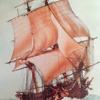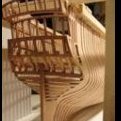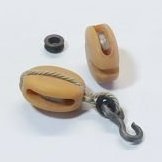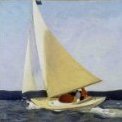Supplies of the Ship Modeler's Handbook are running out. Get your copy NOW before they are gone! Click on photo to order.
×
-
Posts
1,269 -
Joined
-
Last visited
Reputation Activity
-
 AnobiumPunctatum got a reaction from albert in Naval Cutter Alert by AnobiumPuncatum - Scale 1/36 - POF
AnobiumPunctatum got a reaction from albert in Naval Cutter Alert by AnobiumPuncatum - Scale 1/36 - POF
As written in my last post I bought last month the design drawing for Alert/Rattlesnake at the NMM.
With my new knowledge about reconstruction of a line drawing I started to redesign the ship on basis of the NMM drawing.
For this I did not use any information of Goodwin, because it's not a primary source. I don't have access to the archieves so I will only use the NMM drawing and later the vademecum for the scantlings. I am not sure if I like to show my model as designed and shown on the drawing or as shown on the Marshal painting.
Both presentations have the same origin: they should show the design for a ship to the people who allocate the funds.
The drawing isn't finished but I like to hear your meaning about the the reconstructed lines:
It#s my first reconstructed ship, so I am not sure if everything is right.
-
 AnobiumPunctatum got a reaction from Jeronimo in Naval Cutter Alert by AnobiumPuncatum - Scale 1/36 - POF
AnobiumPunctatum got a reaction from Jeronimo in Naval Cutter Alert by AnobiumPuncatum - Scale 1/36 - POF
As written in my last post I bought last month the design drawing for Alert/Rattlesnake at the NMM.
With my new knowledge about reconstruction of a line drawing I started to redesign the ship on basis of the NMM drawing.
For this I did not use any information of Goodwin, because it's not a primary source. I don't have access to the archieves so I will only use the NMM drawing and later the vademecum for the scantlings. I am not sure if I like to show my model as designed and shown on the drawing or as shown on the Marshal painting.
Both presentations have the same origin: they should show the design for a ship to the people who allocate the funds.
The drawing isn't finished but I like to hear your meaning about the the reconstructed lines:
It#s my first reconstructed ship, so I am not sure if everything is right.
-
 AnobiumPunctatum reacted to Zbigniew in Le Commerce de Marseille by Zbigniew
AnobiumPunctatum reacted to Zbigniew in Le Commerce de Marseille by Zbigniew
Thank you friends for your comments.
cont...
-
 AnobiumPunctatum reacted to EdT in Young America 1853 by EdT - FINISHED - extreme clipper
AnobiumPunctatum reacted to EdT in Young America 1853 by EdT - FINISHED - extreme clipper
Young America - extreme clipper 1853
Part 86 – Middle Deck Inboard Planking
Heavy members – standing strakes – 10” thick by 12” deep are fitted over the waterways and bolted through every frame timber to further reinforce the connection of the deck structure to the frames. These members are joined along their length by hook scarphs as shown in the first photo.
These members were also bolted down into the waterways but I omitted these bolts because they will be covered by the next higher planks.
In the next picture some of those planks are being installed and holes are being drilled for the standing strake bolts.
Note that the top strake being installed is notched for a drop plank to account for the widening planking band where the hull flares out at the bow. The next picture shows a higher strake being glued in – wedged down to close the joint.
Standing strake bolts have been installed in this picture. In the next picture, the next section of that plank is being glued – wedged and clamped in this case.
I did not bother to jog the planking joints in this work, because hanging knees will hide this detail. Long planking strips were used and their joints placed under a knee location.
The next picture shows the completed planking – except for treenails – at the starboard bow.
The gap above the top plank is an “air strake” – left open to ventilate the space between frames above the keel.
The next picture shows the larger of the two fresh water tanks ready to be rigged into the opening in the decks.
In the next picture the tank is placed temporarily in position. The top of this tank will be just below the main deck planking. A smaller tank located just forward of this one has yet to be fabricated.
I did not go overboard in making these tanks. They will be difficult to see at best. I used the wood blocks shown earlier, some file folder and a ponce wheel for the rivets. After assembly the paper was impregnated with dilute shellac and finished with flat black enamel.
The detail of the actual tanks, like many other things, is a bit of a mystery. Webb’s Challenge had rectangular iron tanks so I followed that design. I based the design for these on pictures from the JL Mott catalog from 1886. Mott was the foremost New York ironmonger from 1828, making a large range of iron goods well into the 20th Century – a likely source for these tanks. The catalog featured cast and wrought iron sectional tanks. It is likely that these large tanks would have been of the wrought iron type – probably lead lined. They were built up to the required size in formed modules. The top and bottom manways are speculative. No nozzles yet.
Ed
-
 AnobiumPunctatum reacted to Chuck in HM Cutter Cheerful 1806 by Chuck - FINISHED - 1:48 scale - kit prototype
AnobiumPunctatum reacted to Chuck in HM Cutter Cheerful 1806 by Chuck - FINISHED - 1:48 scale - kit prototype
Windlass 2.0
The final version....no photoshop this time
-
 AnobiumPunctatum reacted to Chuck in HM Cutter Cheerful 1806 by Chuck - FINISHED - 1:48 scale - kit prototype
AnobiumPunctatum reacted to Chuck in HM Cutter Cheerful 1806 by Chuck - FINISHED - 1:48 scale - kit prototype
Seeing as I have to make another windlass anyway...I will alter the plans to show the bar holes on every other face. Its an easy fix. I can see that it would make sense...or to alternate their position should they appear on every face like shown on John;'s example he posted above. Dont y0u wish making changes in real life was as easy as having Photoshop.
Heres what she looks like with every other...piece of cake...
-
 AnobiumPunctatum got a reaction from WackoWolf in HM Cutter Cheerful 1806 by Chuck - FINISHED - 1:48 scale - kit prototype
AnobiumPunctatum got a reaction from WackoWolf in HM Cutter Cheerful 1806 by Chuck - FINISHED - 1:48 scale - kit prototype
Really wonderful windlass. This is one very tricky part and you make to look it so easy.
-
 AnobiumPunctatum reacted to allanyed in Royal Navy Fireship COMET 1783
AnobiumPunctatum reacted to allanyed in Royal Navy Fireship COMET 1783
I had the privilege to preview this book and see the model while under construction and I can say that it is a must for any scratch builder or kit basher. There are a lot of new areas covered that are not to be found in the TFFM series such as an extremely detaled description on building the galleries, not to mention the design and construction of a ship with the specific purpose of being a fire ship.
I was supposed to be proof reading for errors but I became totally engrossed in the text and illustrations and enjoyed the read as much as I found an appreciation for its usefulness to the model builder.
Allan
-
 AnobiumPunctatum got a reaction from albert in Naval Cutter Alert by AnobiumPuncatum - Scale 1/36 - POF
AnobiumPunctatum got a reaction from albert in Naval Cutter Alert by AnobiumPuncatum - Scale 1/36 - POF
My holidays are over so the progress is much slower than before.
I did the keelson before building the frames. So it is in my opinion much easier to adjust it with the fore and after deadwood.
Before glueing the keelson on the backbone It take a long time. All frames have to be installed first.
Today I worked on my first frame. It took quite long to find my way to build the frame. The result is not perfect, but I think doing the next frames will be much easier and faster. If it's interesting for someone I will do a step by step description from building one of the next frames.
-
 AnobiumPunctatum got a reaction from Saburo in Naval Cutter Alert by AnobiumPuncatum - Scale 1/36 - POF
AnobiumPunctatum got a reaction from Saburo in Naval Cutter Alert by AnobiumPuncatum - Scale 1/36 - POF
After the drawing works it was time to make sawdust.
First part is the keel, which is a little bit tricky. The keel has a light curvature and the joints are perpendicular to the base line.
I cut some small stripes with my cirular saw, make the joints and glue the parts together. Next I added the parts for the stem.
The picture shows the step on the building board. I use Tamiya Tape to avoid that the keel glues on the paper during the build.
The next pictures show the complete assembled backbone for the small vessel,
the stem with with the changed layout of the parts,
the keel and the rising wood,
and the stern post with the after deadwood.
The next steps are cutting the rabbet, the keelson and the building board. Then I can start with the frames.
-
 AnobiumPunctatum got a reaction from Saburo in Naval Cutter Alert by AnobiumPuncatum - Scale 1/36 - POF
AnobiumPunctatum got a reaction from Saburo in Naval Cutter Alert by AnobiumPuncatum - Scale 1/36 - POF
I was really suprised that I did not find a build log about the Naval Cutter Alert on MSW 2.0. I know that there exist some pictures of a model on the old MSW
The first source for building a model of this small vessel are Peter Goodwins book "The Naval Cutter Alert, 1777", published by PhoenixPublications Inc. 1991 and the two original drawing of her sister Rattlesnake (1776) which you will find on the homepage of the NMM.
There also exist two paintings of Joseph Marshall of the ship, which are exhibited in the Science Museum, London.
I found also an Sheer and Profile drawing of Alert which was published by the NRG.
The sheer and profile of the NRG and Goodwin differ from the original drawing. They show the maximum width of the ship not at frame 0. Perhaps my Engish is to bad, but I could not find any reason for this. So I decide to draw my own lines. which were based on Goodwin and the original drawing.
The drawing is not finished, because I decided only to draw what I need for my build.
Next step was the keel. Goodwin shows for the pass between keel and lower apron a solution which I could not find on any original cutter drawings.
For the after deadwood he does not offer any possible solution
I decide to follow the original drawing of Cheerful 1806 for the pass between keel and lower apron. The flat joint at the foremost keel part is shown on original drawings of this period (for example on HMS Triton). For the after deadwood I decided to use a bearing line. I am not sure if this is common for ships of this period.
The next picture shows my completed keel drawing:
Goodwin uses for his design the common frameing pattern of double and single frames. I am not sure that this design was used for the original ship. For the Swan class sloops only single frames were used. This you will also find on the drawing of Cheerful and other cutters. Also the wide of the frame parts are not clear. In his drawing he uses much smaller futtocks than he descibed in the text part of the book. In his "Construction and Fitting of Sailing Man of War" he gives a third solution.
What now? Alert is a practice model for me to get the experience to continue my HMS Fly build. Marshall shows on his paintings an simplified frameing design, so I decided to use this. Every frame is 8'' width followed by 8'' space. For the port side I like to show the clinker planking.
On my drawing the final design for the last frame and the hawse pieces is missing in the moment.
The drawings for every 31frames and 21cant frames are finished.
I am not sure in the moment if I will use the original practice with chocks or the simplified method of Harold Hahn for my build.
It will be very nice if you have further information about the cutters of this time. I found the Marmaduke Stalkartt on Google-books, but they didn't scan the plates. Perhaps one of the MSW user can help me to confirm my decisions.
-
 AnobiumPunctatum got a reaction from harvey1847 in HMS Triton 1773. POF. 1:48. Daniel
AnobiumPunctatum got a reaction from harvey1847 in HMS Triton 1773. POF. 1:48. Daniel
Hi Daniel,
very impressive progress in the last month
-
 AnobiumPunctatum reacted to Chuck in HM Cutter Cheerful 1806 by Chuck - FINISHED - 1:48 scale - kit prototype
AnobiumPunctatum reacted to Chuck in HM Cutter Cheerful 1806 by Chuck - FINISHED - 1:48 scale - kit prototype
I think the fore most shroud would do the most damage. Its a mystery. There are other cutters I have examined and its usually both the fore shroud and the aft shroud or none of them. I have never seen just the aft one served.
The way the stay is rigged with two deadeyes....plain with three holes is also a curious detail I have not seen before. I am going with the more tradition rig. Based on the Surly in the other museum.
Chuck
-
 AnobiumPunctatum reacted to Chuck in HM Cutter Cheerful 1806 by Chuck - FINISHED - 1:48 scale - kit prototype
AnobiumPunctatum reacted to Chuck in HM Cutter Cheerful 1806 by Chuck - FINISHED - 1:48 scale - kit prototype
I also wanted to post some photos of the Rogers collection model. I should have done so earlier on in this log. It is identified as Cheerful but after much scrutiny it is not. At least in my opinion. The measurements on deck match but thats about it. There are too many stunning discrepancies when compared to the original drafts. But its very close. It is a cutter of the same period and for research its very valuable.
The rigging is quite odd as well. Nothing I have ever seen on a cutter of this period. It is interesting to note that until recently this model was identified as an unknown cutter circa 1770's. I am not sure who actually mis-identified it as Cheerful but it has changed at least three times in literature that refers to the Rogers collection.
Its a great model non-the-less. What I was glad to see was it is not Clinker planked. One of the reasons I chose this subject. I also have many photos of the square tuck...note the vertical planking back there as opposed to the usual diagonal. This is a detail that is also shown on the original draft. Also note the gunnades on deck. These are the carronades on carriages rather than sleds. This model does not have long twelves at the bow which Cheerful did have. Instead it has more gunnades. Also note such peculiar things such as the aft most shroud being served but the fore shroud is not. Go figure.
Any question and I would be glad to try and answer them. I have tons of photos. I also have some photos of the only sister....in this class, Surly. This is another contemporary model in a Canadian museum. It shows this class after a major refit. One that Cheerful never had because it had such a short life.
Chuck
-
 AnobiumPunctatum got a reaction from reilly in Naval Cutter Alert by AnobiumPuncatum - Scale 1/36 - POF
AnobiumPunctatum got a reaction from reilly in Naval Cutter Alert by AnobiumPuncatum - Scale 1/36 - POF
@Rich,
I fixed the broken picture links. Hopefully all pictures are now visible again.
@all
Sorry that I didn't make an update for a long time. Sometimes real life lets not really time for modelbuilding.
In the moment I am waiting for the original plan of the Rattlesnake which I ordered at the NMM. There are a lot of details where I am not happy with my design which I made on basis of the AotS book. Last year I traced the lines as described in an article of the MSW database. But meanwhile I learned a lot about doing an new reconstruction on basis of an original drawing. This I will try to do for the cutter after the original drawing arrived.
Perhaps one of our admins can change scale in the title, because I like to build the model in 1/32. The bigger scale gives me a lot more possibilities for makeing the klinker planking.
At last I have a question:
Roger Cole refers in his article about his model on an article which was published in Nautical Research Journal Vol 29, Number 4 December 1983:
Kingman, Irving H: Modeling HMB Cutter Alert - 1777. Perhaps someone can help me with a copy. Thanks.
-
 AnobiumPunctatum got a reaction from harvey1847 in Naval Cutter Alert by AnobiumPuncatum - Scale 1/36 - POF
AnobiumPunctatum got a reaction from harvey1847 in Naval Cutter Alert by AnobiumPuncatum - Scale 1/36 - POF
@Rich,
I fixed the broken picture links. Hopefully all pictures are now visible again.
@all
Sorry that I didn't make an update for a long time. Sometimes real life lets not really time for modelbuilding.
In the moment I am waiting for the original plan of the Rattlesnake which I ordered at the NMM. There are a lot of details where I am not happy with my design which I made on basis of the AotS book. Last year I traced the lines as described in an article of the MSW database. But meanwhile I learned a lot about doing an new reconstruction on basis of an original drawing. This I will try to do for the cutter after the original drawing arrived.
Perhaps one of our admins can change scale in the title, because I like to build the model in 1/32. The bigger scale gives me a lot more possibilities for makeing the klinker planking.
At last I have a question:
Roger Cole refers in his article about his model on an article which was published in Nautical Research Journal Vol 29, Number 4 December 1983:
Kingman, Irving H: Modeling HMB Cutter Alert - 1777. Perhaps someone can help me with a copy. Thanks.
-
 AnobiumPunctatum got a reaction from seaman.spb in Naval Cutter Alert by AnobiumPuncatum - Scale 1/36 - POF
AnobiumPunctatum got a reaction from seaman.spb in Naval Cutter Alert by AnobiumPuncatum - Scale 1/36 - POF
My holidays are over so the progress is much slower than before.
I did the keelson before building the frames. So it is in my opinion much easier to adjust it with the fore and after deadwood.
Before glueing the keelson on the backbone It take a long time. All frames have to be installed first.
Today I worked on my first frame. It took quite long to find my way to build the frame. The result is not perfect, but I think doing the next frames will be much easier and faster. If it's interesting for someone I will do a step by step description from building one of the next frames.
-
 AnobiumPunctatum got a reaction from Chuck in Naval Cutter Alert by AnobiumPuncatum - Scale 1/36 - POF
AnobiumPunctatum got a reaction from Chuck in Naval Cutter Alert by AnobiumPuncatum - Scale 1/36 - POF
@Rich,
I fixed the broken picture links. Hopefully all pictures are now visible again.
@all
Sorry that I didn't make an update for a long time. Sometimes real life lets not really time for modelbuilding.
In the moment I am waiting for the original plan of the Rattlesnake which I ordered at the NMM. There are a lot of details where I am not happy with my design which I made on basis of the AotS book. Last year I traced the lines as described in an article of the MSW database. But meanwhile I learned a lot about doing an new reconstruction on basis of an original drawing. This I will try to do for the cutter after the original drawing arrived.
Perhaps one of our admins can change scale in the title, because I like to build the model in 1/32. The bigger scale gives me a lot more possibilities for makeing the klinker planking.
At last I have a question:
Roger Cole refers in his article about his model on an article which was published in Nautical Research Journal Vol 29, Number 4 December 1983:
Kingman, Irving H: Modeling HMB Cutter Alert - 1777. Perhaps someone can help me with a copy. Thanks.
-
 AnobiumPunctatum got a reaction from CiscoH in Naval Cutter Alert by AnobiumPuncatum - Scale 1/36 - POF
AnobiumPunctatum got a reaction from CiscoH in Naval Cutter Alert by AnobiumPuncatum - Scale 1/36 - POF
After the drawing works it was time to make sawdust.
First part is the keel, which is a little bit tricky. The keel has a light curvature and the joints are perpendicular to the base line.
I cut some small stripes with my cirular saw, make the joints and glue the parts together. Next I added the parts for the stem.
The picture shows the step on the building board. I use Tamiya Tape to avoid that the keel glues on the paper during the build.
The next pictures show the complete assembled backbone for the small vessel,
the stem with with the changed layout of the parts,
the keel and the rising wood,
and the stern post with the after deadwood.
The next steps are cutting the rabbet, the keelson and the building board. Then I can start with the frames.
-
 AnobiumPunctatum got a reaction from Jay 1 in Naval Cutter Alert by AnobiumPuncatum - Scale 1/36 - POF
AnobiumPunctatum got a reaction from Jay 1 in Naval Cutter Alert by AnobiumPuncatum - Scale 1/36 - POF
@Rich,
I fixed the broken picture links. Hopefully all pictures are now visible again.
@all
Sorry that I didn't make an update for a long time. Sometimes real life lets not really time for modelbuilding.
In the moment I am waiting for the original plan of the Rattlesnake which I ordered at the NMM. There are a lot of details where I am not happy with my design which I made on basis of the AotS book. Last year I traced the lines as described in an article of the MSW database. But meanwhile I learned a lot about doing an new reconstruction on basis of an original drawing. This I will try to do for the cutter after the original drawing arrived.
Perhaps one of our admins can change scale in the title, because I like to build the model in 1/32. The bigger scale gives me a lot more possibilities for makeing the klinker planking.
At last I have a question:
Roger Cole refers in his article about his model on an article which was published in Nautical Research Journal Vol 29, Number 4 December 1983:
Kingman, Irving H: Modeling HMB Cutter Alert - 1777. Perhaps someone can help me with a copy. Thanks.
-
 AnobiumPunctatum reacted to Trussben in HMS Pegasus 1776 by Trussben - 1:48 - Swan-class sloop based on TFFM
AnobiumPunctatum reacted to Trussben in HMS Pegasus 1776 by Trussben - 1:48 - Swan-class sloop based on TFFM
Fore Cants up to #10 have been installed, now to make #11 with the 2" cast top timber for the forward gunport.
Ben
-
 AnobiumPunctatum got a reaction from CiscoH in Naval Cutter Alert by AnobiumPuncatum - Scale 1/36 - POF
AnobiumPunctatum got a reaction from CiscoH in Naval Cutter Alert by AnobiumPuncatum - Scale 1/36 - POF
I was really suprised that I did not find a build log about the Naval Cutter Alert on MSW 2.0. I know that there exist some pictures of a model on the old MSW
The first source for building a model of this small vessel are Peter Goodwins book "The Naval Cutter Alert, 1777", published by PhoenixPublications Inc. 1991 and the two original drawing of her sister Rattlesnake (1776) which you will find on the homepage of the NMM.
There also exist two paintings of Joseph Marshall of the ship, which are exhibited in the Science Museum, London.
I found also an Sheer and Profile drawing of Alert which was published by the NRG.
The sheer and profile of the NRG and Goodwin differ from the original drawing. They show the maximum width of the ship not at frame 0. Perhaps my Engish is to bad, but I could not find any reason for this. So I decide to draw my own lines. which were based on Goodwin and the original drawing.
The drawing is not finished, because I decided only to draw what I need for my build.
Next step was the keel. Goodwin shows for the pass between keel and lower apron a solution which I could not find on any original cutter drawings.
For the after deadwood he does not offer any possible solution
I decide to follow the original drawing of Cheerful 1806 for the pass between keel and lower apron. The flat joint at the foremost keel part is shown on original drawings of this period (for example on HMS Triton). For the after deadwood I decided to use a bearing line. I am not sure if this is common for ships of this period.
The next picture shows my completed keel drawing:
Goodwin uses for his design the common frameing pattern of double and single frames. I am not sure that this design was used for the original ship. For the Swan class sloops only single frames were used. This you will also find on the drawing of Cheerful and other cutters. Also the wide of the frame parts are not clear. In his drawing he uses much smaller futtocks than he descibed in the text part of the book. In his "Construction and Fitting of Sailing Man of War" he gives a third solution.
What now? Alert is a practice model for me to get the experience to continue my HMS Fly build. Marshall shows on his paintings an simplified frameing design, so I decided to use this. Every frame is 8'' width followed by 8'' space. For the port side I like to show the clinker planking.
On my drawing the final design for the last frame and the hawse pieces is missing in the moment.
The drawings for every 31frames and 21cant frames are finished.
I am not sure in the moment if I will use the original practice with chocks or the simplified method of Harold Hahn for my build.
It will be very nice if you have further information about the cutters of this time. I found the Marmaduke Stalkartt on Google-books, but they didn't scan the plates. Perhaps one of the MSW user can help me to confirm my decisions.
-
 AnobiumPunctatum reacted to Remcohe in HMS Kingfisher 1770 by Remcohe - 1/48 - English 14-Gun Sloop - POF
AnobiumPunctatum reacted to Remcohe in HMS Kingfisher 1770 by Remcohe - 1/48 - English 14-Gun Sloop - POF
So after lots of holes and filling them up again .....
The hull ready to be sanded
Close up of the end result
Remco
-
 AnobiumPunctatum got a reaction from Jeronimo in HMS Kingfisher 1770 by Remcohe - 1/48 - English 14-Gun Sloop - POF
AnobiumPunctatum got a reaction from Jeronimo in HMS Kingfisher 1770 by Remcohe - 1/48 - English 14-Gun Sloop - POF
Really wonderful Remco
-
 AnobiumPunctatum reacted to Remcohe in HMS Kingfisher 1770 by Remcohe - 1/48 - English 14-Gun Sloop - POF
AnobiumPunctatum reacted to Remcohe in HMS Kingfisher 1770 by Remcohe - 1/48 - English 14-Gun Sloop - POF
Guys,
Thank you for all the positive comments of the outside planking.
Jan you are right I should not whine over a 0.5 micron fault. It casts a shadow over what the hobby is really about:
enjoying building something with your hands, whether from a kit or scratch, of a subject we have interest in, share here on MSW and learn to make the next build better than the one in the shipyard. And of course having fun with this merry band of mad man
And let the other four behold my sore thumb
And this is what I learned, first draw the run of all the planking on the hull before starting to plank. This would have avoided my 0.5 micron mistake.
And because I don't like to post without a picture, I have a severe outbreak of Anobium punctatum in my shipyard. I try to repair the damage done with size 400 micron treenails
Remco








